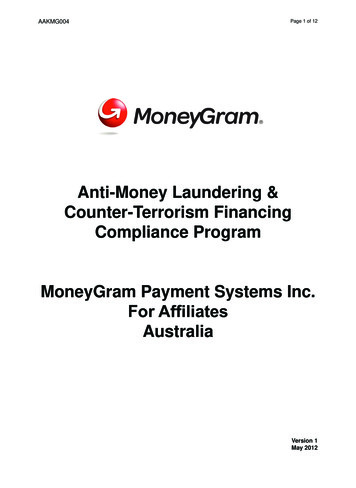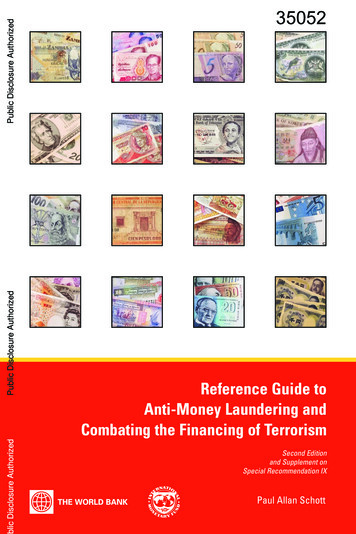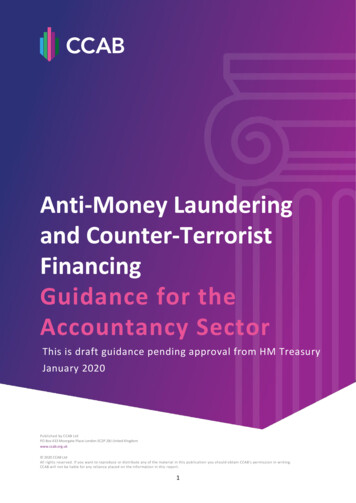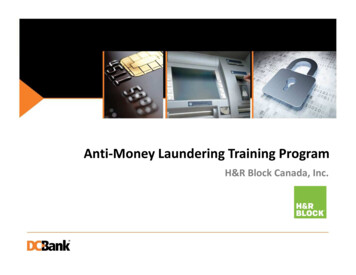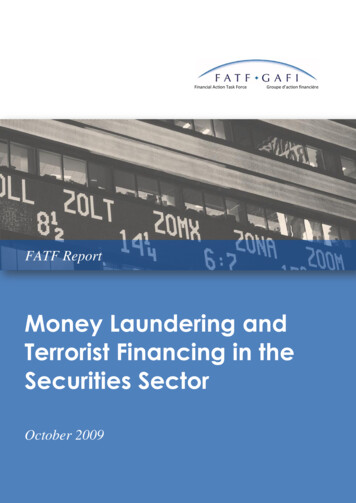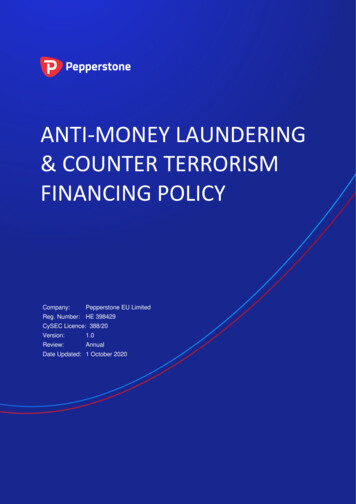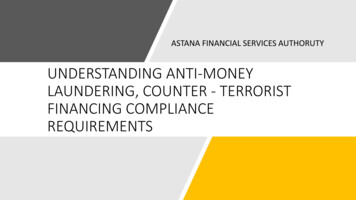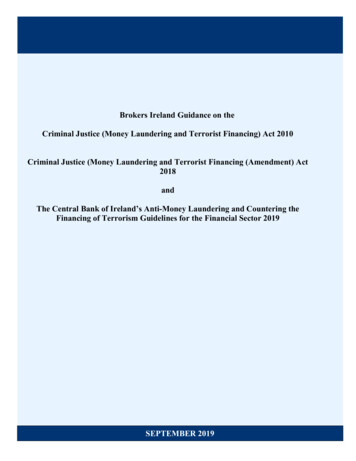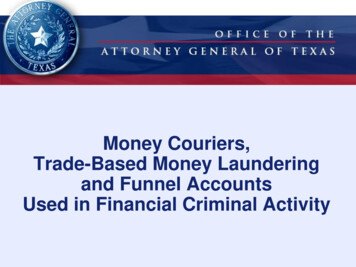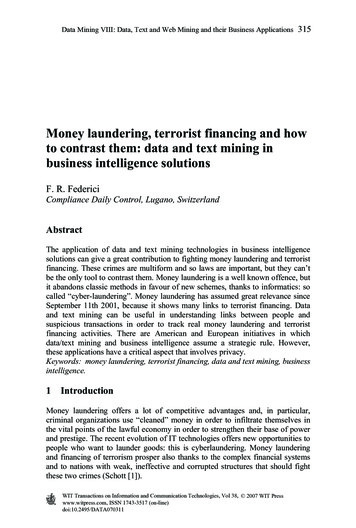
Transcription
Data Mining VIII: Data, Text and Web Mining and their Business Applications315Money laundering, terrorist financing and howto contrast them: data and text mining inbusiness intelligence solutionsF. R. FedericiCompliance Daily Control, Lugano, SwitzerlandAbstractThe application of data and text mining technologies in business intelligencesolutions can give a great contribution to fighting money laundering and terroristfinancing. These crimes are multiform and so laws are important, but they can’tbe the only tool to contrast them. Money laundering is a well known offence, butit abandons classic methods in favour of new schemes, thanks to informatics: socalled “cyber-laundering”. Money laundering has assumed great relevance sinceSeptember 11th 2001, because it shows many links to terrorist financing. Dataand text mining can be useful in understanding links between people andsuspicious transactions in order to track real money laundering and terroristfinancing activities. There are American and European initiatives in whichdata/text mining and business intelligence assume a strategic rule. However,these applications have a critical aspect that involves privacy.Keywords: money laundering, terrorist financing, data and text mining, businessintelligence.1IntroductionMoney laundering offers a lot of competitive advantages and, in particular,criminal organizations use “cleaned” money in order to infiltrate themselves inthe vital points of the lawful economy in order to strengthen their base of powerand prestige. The recent evolution of IT technologies offers new opportunities topeople who want to launder goods: this is cyberlaundering. Money launderingand financing of terrorism prosper also thanks to the complex financial systemsand to nations with weak, ineffective and corrupted structures that should fightthese two crimes (Schott [1]).WIT Transactions on Information and Communication Technologies, Vol 38, 2007 WIT Presswww.witpress.com, ISSN 1743-3517 (on-line)doi:10.2495/DATA070311
316 Data Mining VIII: Data, Text and Web Mining and their Business ApplicationsAfter 11th September, the interest in the financing of terrorism has grown:this crime is often indicated as “reverse money laundering”, because in manycases the process begins from the presence of financial stocks of licit origin inorder to hide the destination finalized to commit a criminal or a terrorist action.These goods often pass through the Informal Value Transfer System (IVTS),networks of people based on confidence and personal relationships (Schneider[2]). This way supplies a good capillarity, because money must be available tothe operating cells all over the world. However, the International Monetary Fund[3] has estimated that the amount aggregate of laundered money in the world canbe comprised between the 2 and 5% of the world-wide Pil, that in monetaryvalues can be translated in approximately 1,5 trillions of .2Is it all ok?Present anti-money laundering (AML) strategy was conceived at the end of the80s. The hinge of such repressive system is in the cooperation of financialprofessionals and banking system, including more recently and extensively,operators like lawyers and accountants, but also operators that are not financial(real estate mediation, commerce of jewels, etc.) which are called to support theactivity of monitoring and protection of the legal system from the exploitation byinternational terrorism. The international AML standard is represented by theForty Recommendations prepared by the Financial Action Task Force on MoneyLaundering (FATF) [4]. Since October 2001 there are also Nine SpecialRecommendations on Terrorist Financing (FATF [5]).Some factors are important: identification and acquaintance of the customer;recording of the operations above a threshold, both with a single operation andwith a sequence of operations in the arc of a determined period; thecommunication of suspect operations to the national AML agency. There aresome weaknesses in this strategy: they can be found, in particular, in the systemsof payment via Internet, that make possible to carry out “peer-to-peer” paymentswith cryptographic applications and different levels of anonymity. Greatconfidentiality is obtained moreover, historically, through tax and financialhavens. These methods don’t make easy controlling activities, especially whenthere are several passages between more users before the demand for conversion.Surely it’s more difficult to control IVTS, Meldrum and Ciotti Galletti [6].That’s way it’s impossible to define a "passpartout" money launderingprevention.3A new strategyMoney laundering and terrorist financing are phenomena that are not explainedonly by laws or by technique, but they have a social dimension. Amultidimensional approach occurs: it should show the complexity and thesystemic nature of the two crimes. Improving the informative databases ofseveral institutions can lead, thanks to business intelligence (BI), to a progressiveWIT Transactions on Information and Communication Technologies, Vol 38, 2007 WIT Presswww.witpress.com, ISSN 1743-3517 (on-line)
Data Mining VIII: Data, Text and Web Mining and their Business Applications317convergence and integration of knowledge management systems, in order toinvestigate not only unusual money transactions or a high recurrence of thetransactions, but also to discover unexpected relations that can gush from data.Links between a person, or some people, and the transactions are the crucial fact.Fighting money laundering and the financing of terrorism needs meticulousexamination of these links as a fundamental process: it must include networks’analysis, in particular Internet, wire-tapping and travels’ analysis, with the fusionof not classified sources and hidden intelligence, like the electronic interceptions.BI is important to give meaningful links in order to trace criminal activities. BIhelps the user to take effective and timely decisions, thanks to a comprehensivevision of the activity in analyzing. For example, the fact that a transaction hasexceeded a determined threshold can be integrated with other pieces ofinformation that define the context in which the operation takes place.People who work using these technologies have developed tools that facilitatethe collection and the analysis of great amounts of structured and not structureddata: many solutions of BI, in fact, include tools of data and text mining. Datamining (DM) is the process that, through mathematical techniques and statistics,extracts valid and exploitable information, previously unknown, from greatamounts of structured data, that are already included in databases, organized andready for being managed easily from IT applications (Zanasi et al. [7]). The DM,in fact, is distinguished from the traditional approaches of data analysis, becausethe obtained information is completely new. It must be also valid in order toavoid wrong or not useful data. DM can be used for many purposes: marketmanagement, risk management and fraud management. The principal operationsare predictive modelling, database segmentation, link analysis and deviationdetection, together with different techniques, Figure 1.Text mining (TM) is the process that extracts information from not structureddata, as they can be texts, in analogical and digital format (Zanasi [8]), Figure 2.Figure 1:DM applications, Zanasi et al. [7].WIT Transactions on Information and Communication Technologies, Vol 38, 2007 WIT Presswww.witpress.com, ISSN 1743-3517 (on-line)
318 Data Mining VIII: Data, Text and Web Mining and their Business ApplicationsFigure 2:Figure 3:TM process, Zanasi [8].Mining processes and BI, Zanasi et al. [7].When such information is available, it can be analysed and compared with therest of the informative patrimony of BI. There are different technologies,classified in accordance with their potential value to support business decisions.Lots of people give their contribution to exploit the power of BI systems:database administrators, data analysts, business analysts. They work together toprovide the end user the capabilities to make well pondered decisions troughuser-friendly interfaces, Figure 3.WIT Transactions on Information and Communication Technologies, Vol 38, 2007 WIT Presswww.witpress.com, ISSN 1743-3517 (on-line)
Data Mining VIII: Data, Text and Web Mining and their Business Applications4319The potential of text miningTM is an interdisciplinary field that it is based on the DM, statisticalmathematical techniques and linguistics. The first TM applications appeared inthe second half of 80s, but developed in the 90s. So this technology is recent, buthas however great potentialities and many uses: in fact, it can extract informationfrom great amounts of textual data, classify it in thematic categories, but alsoshow unexpected correlations of high informative value. Typical organizationsthat can need TM are credit institutions, assurances, intermediation societies,financial institutions, research centres and generally all those agencies that haveto manage great volumes of documents. Many experts emphasize humanparticipation in the development of the process: users must be aware of somelimits of this technology and, therefore, they must integrate them with humandiscernment, in order to avoid wrong conclusions on the base of the presenteddata. It isn’t useful working with this software “as it is”.4.1 FactivaTo fight money laundering and terrorist financing, Factiva TM [9] offers aninteresting function with the program "Public Figures & Associates" (PFA): itsupplies detailed profiles - political, economic, social condition and otherbiographical details - of 500.000 politically sensitive people all over the worldand of those people that are linked to them, like relatives and friends, with therecording of orthographical variations and alias. PFA includes also an internetcrawler. The list of individuals implemented in PFA presents the names ofknown terrorists and criminals of different species, but also potential criminals.4.2 RDCSomething similar to the PFA is the service that is in the RDC suite for AML[10], GRID, the Global Regulatory Information Database, a collection of datathat contains approximately 1,5 million people: everyday there are updates andthe new entries are approximately 700-800 everyday. The sources of data aregovernmental or Interpol lists but also newspapers, reviews, transcriptions of TVand radio, Internet, etc.4.3 TEMIS“Text Mining 360 Skill Cartridge” is the suite of TEMIS [11], an advanced toolfor text analysis that concurs to the automatic content exploration of all types oftextual data. XeLDA, the multilanguage engine, standardizes unstructureddocuments in order to explore their content. Two key factors of TEMIS suite arethe dictionaries and the rules of entity extraction. The Insight DiscovererExtractor is a server for the information extraction in textual documents thatincludes automatic identification of the language, morpho-syntactic analysis ofwords, and knowledge extraction, that is the identification of relations betweenWIT Transactions on Information and Communication Technologies, Vol 38, 2007 WIT Presswww.witpress.com, ISSN 1743-3517 (on-line)
320 Data Mining VIII: Data, Text and Web Mining and their Business Applicationsentities: this demonstrates great usefulness in finding connections betweenpeople and financial transactions. A clear example of these networks ofconnections is shown in Figure 4.Figure 4:5Connections between people and transactions, TEMIS [11].American and European initiativesThere are, in particular, two wider projects that include such technologies: thefirst, ADVISE (Analysis, Dissemination, Visualization, Insight and SemanticEnhancement), is American, and the second is the European Security ResearchProgramme (ESRP), to whose implementation contributes ESRAB, the EuropeanSecurity Research Advisory Board.5.1 USA: ADVISEThe Homeland Security Department [12] often manages an enormous amount ofdata, whose value cannot be explored without technologies for the knowledgemanagement, like BI. There are a lot of objectives: for example, theidentification of terrorist threats and vulnerabilities and the discovery of terroristfinancing activities. The user-friendly interfaces, linked to BI, are important forthe entire architecture of ADVISE: they, together with fast simulations, arefundamental in order to discover the complex relations between people andtransactions and so they can obtain useful information to fight terrorism.Analyzing text data, in particular, is difficult and highly labour intensive: forthis reason ADVISE cannot be based exclusively on a manual extraction, but it isequipped with automatic tools that can arrange typical DM and TM techniques.To find information from databases and to make link analysis on the structuredWIT Transactions on Information and Communication Technologies, Vol 38, 2007 WIT Presswww.witpress.com, ISSN 1743-3517 (on-line)
Data Mining VIII: Data, Text and Web Mining and their Business Applications321information, data must be converted and formatted in order to be stored indatawarehouse, Coffman et al. [13]. The first step of the text analysis process isthe transformation of not structured documents into structured ones. ADVISEimplements therefore sophisticated technologies, Figure 5. In particular TMshows great potential in the selective study of e-mail traffic in order to foilterrorist plans.Figure 5:Different typologies of data for a query, DHS.5.2 UE: ESRPIn the 2003 the European Commission called a Group of Personalities in the fieldof security research. The primary aim was to propose principles and priorities ofESRP. From the report "The Research for a Secure Europe", introduced from theGroup in 2004, it’s clear that the Communication of Commission (COM 2004590 final, entitled "Security Research: the Next Steps") [14] proposed thecreation of ESRAB. ESRAB should contribute to the content and theimplementation of ESRP, already financed with 3 billions of Euro, inside of7 FP-Framework Program [15]. ESRAB is composed by fifty experts comingfrom several fields: 25 from Institutions and 25 from private companies, industryand research organizations. The Commission can consult ESRAB on every issuerelative to security. ESRAB presents recommendations in many areas, inparticular: strategic missions, warm areas and priorities established for ESRP onthe base of the report "Research for a Secure Europe" and considering thecreation of the European Defense Agency, together with national activities; thetechnological abilities are strategic in order to improve the technological base ofthe European industry in the field of security research and competitiveness.WIT Transactions on Information and Communication Technologies, Vol 38, 2007 WIT Presswww.witpress.com, ISSN 1743-3517 (on-line)
322 Data Mining VIII: Data, Text and Web Mining and their Business ApplicationsInside ESRP there’s a financing to the development of AML technologies andsolutions. The mission areas in which ESRP acts are: protection against terrorismand organized crime, borders security, protection of critical infrastructures andsecurity restoration in crisis situation [16,17]. In all these fields informationmanagement systems are fundamental in order to supply the greatest knowledgeand ability to manage crisis to decision maker, Table 1.Table 1:First two priority technology areas of ESRP.Technology DomainSignal and information technologiesPriority Technology Areas data fusion techniques data collection/classification image/pattern processing information fusion technology data & information managementtechnology (DB, etc.)Artificial Intelligence and decision data & text miningsupport IKBS/AI/expert techniques knowledge management modelling and simulation optimisation & decision supporttechnologyThe result is a system that analyzes information deriving from financial,demographic data and from investigative agencies to draw better conclusionsthanks to: discovery of common behavioural characteristics in terrorismfinancing and money laundering; data extraction and discovery of pattern andhidden correlations that indicate a specific threat and the presentation of the datain order to help the decisional process; models of forecast and correlation inorder to generate warning on eventual future threats; automatic tools to seecriminal behaviours.6PrivacyThe applications I have described have a critical aspect, linked to the privacy. Infact, secrecy is a remarkable barrier for the relative intelligence activities. Therelationship between the collaboration of the institutions and AML activity isundoubtedly based on a game of delicate equilibrium: defence of the societyfrom the criminal phenomena, protection of business and respect of privacy. Itwill be difficult, therefore, to conciliate the development of the intelligenceoperations with the respect of the honest citizens’ privacy. Zanasi [18] sharplysays that unfortunately there’s little privacy in digital society and protectivemeasures have appeared not effective, because teenager crackers have penetratedinto “protected” systems all over the world.WIT Transactions on Information and Communication Technologies, Vol 38, 2007 WIT Presswww.witpress.com, ISSN 1743-3517 (on-line)
Data Mining VIII: Data, Text and Web Mining and their Business Applications323Mark Rotenberg says that DM and TM are useful to fight money launderingand terrorist financing, but there’s the idea that they can be used for otherpurposes (industrial espionage, customer profiling, political sentiment analysis,etc.), Kelley [19]. Public authorities’ interference into citizens’ private lifeshouldn’t be set by generic discretion, as it happens in many situations Mulinari[20], but it must be practised only with in front of defence necessity of oursociety under control measures and with guaranties to avoid misuses: a “checksand balances” system must be adopted (Palmieri [21]).Winston Churcill said: “We live in democracy when who knocks on the doorat 7 in the morning can only be the milkman” (Palmieri [22]).7ConclusionsDM and TM, implemented in BI solutions, can give a remarkable contributionfor an effective strategy in the fight against money laundering and terroristfinancing. These tools have some limits. They are not completely self-sufficientand immediately usable “as they are”. It’s necessary that expert analysts mayknow how to structure, analyze and interpret the output that the software hascreated. Although these instruments can help to find patterns and connectionsbetween many entities, they often don’t present their value and meaning in animmediate way: the user must conduct the analysis. Terrorists usually use IVTSand financing sources that are difficult to discover. Greater success would beprobably obtained using DM and TM techniques, like link analysis, with datafusion, in order to create specific behaviour models thanks to a massive use ofsensitive data, but in this case privacy is over. The effectiveness of thesetechnologies has been demonstrated, but the eternal dilemma is still difficult toresolve: security or freedom?References[1][2][3][4][5]Schott P.A., “Reference guide to anti-money laundering e combating thefinancing of terrorism”, chapter 1, 2006.Schneider F., “The hidden financial flows of Islamic terroristorganisations: some preliminary results from an economic perspective”,Johannes Kepler University of Linz, 2003.International Monetary Fund http://www.imf.org/external/data.htm.FATF Financial Action Task Force on Money Laudering – Grouped’Action Financière International (GAFI) - The Forty 28/0,2340,en 32250379 32236930 33658140 1 1 1 1,00.html#40recs.FATF Financial Action Task Force on Money Laudering – Grouped’Action Financière International (GAFI) - Nine SpecialRecommendations on Terrorist Financing (October 2001 versions,updated 22 October 2004) http://www.fatf-gafi.org/document/9/0,2340,en 32250379 32236920 34032073 1 1 1 1,00.html.WIT Transactions on Information and Communication Technologies, Vol 38, 2007 WIT Presswww.witpress.com, ISSN 1743-3517 (on-line)
324 Data Mining VIII: Data, Text and Web Mining and their Business 6][17][18][19][20][21][22]Meldrum C., Ciotti Galletti S., “The logistics of Terrorism and OrganisedCrime: Networks, Convergences and Implications”, European Society ofCriminology 6th Annual Conference, University of Tübingen, August 2629 2006.Zanasi A., Hadjinian P., Stadler R., Verhees J., Cabena P., “Discoveringdata mining – From concept to implementation”, Prentice Hall Ptr, UpperSaddle River, NJ, 1998.Zanasi A., “Text mining and its Applications to Intelligence, CRM andKM”, Wit Press, 2005.Factiva Dow Jones & Reuters Company, http://www.factiva.com.RDC, Regulatory Data Corp, http://www.regulatorydatacorp.com.TEMIS Text Intelligence, http://www.temis-group.com.DHS Workshop on data sciences, “Data sciences Technology forHomeland Security Information Management and Knowledge Discovery,p.21, 22-23 September 2005.Coffman T., Greenblatt S., Sherry M., “Graph-based Technologies forIntelligence Analysis”, Communication of the Acm, vol.47, n.3, March2004.COM 2004 590 final, "Security Research: the Next Steps", Brussels7/9/2004, 04 0590en01.pdf.7 FP – Framework Program, ion of the European Communities, “Green paper on detectiontechnologies in the work of law enforcement, customs and other securityauthorities”, p.5, Brussels 1/9/2006, COM(2006) 474 final“Meeting the challenge: the European Security Research Agenda. A reportfrom the European Security Research Advisory Board”, pp.29-33,September 2006.Zanasi A., “Nuove forme di guerra, nuove forme di intelligence: il textmining”, Modernizzazione e Sviluppo (Quaderni del Centro GinoGermani), n.3, “Intelligence nel XXI secolo, p.5, 2001.Kelley M., “Feds sharpen secret tools for data mining”, USA TODAY,20/07/2006.Mulinari S., “Cyberlaundering. Riciclaggio di capitali, finanziamento ”,PricewaterhouseCoopers, Pearson Prentice Hall, pp.292-293, 2003.Palmieri N.W., “Diritti fondamentali a rischio”, Pitagora, p.15, 2003.Palmieri N.W., “Sicurezza o libertà? Introduzione al diritto di internet”,Pitagora, p.9, 2004.WIT Transactions on Information and Communication Technologies, Vol 38, 2007 WIT Presswww.witpress.com, ISSN 1743-3517 (on-line)
data/text mining and business intelligence assume a strategic rule. However, these applications have a critical aspect that involves privacy. Keywords: money laundering, terrorist financing, data and text mining, business intelligence. 1 Introduction Money laundering offers a lot of competitive advantages and, in particular,
